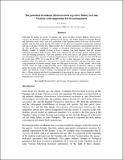| dc.description.abstract | Following the decline in catches of endemic fish species in Lake Victoria, Mukene, Rastrineobola
argentea has become an important commercial fish species. The fishery spread first through Kenyan,
and Tanzanian waters and is now well established in the Ugandan portion of the lake. Rastrineobola,
together with the Nile perch and the Nile tilapia are the three most important commercially exploited
fish species in Lake Victoria now. High mortality due to human exploitation and predation pressure by
the Nile perch have contributed to changes in biological characteristics of mukene populations.
Monthly samples of mukene covering at least a calendar year were obtained from the artisanal
fishermen operating in Lake Victoria. These were analyzed for size structure, growth, gonad maturity
state and breeding periodicity. Type and quantities of by-catch species and parasite infestation were
also determined. Size structure of mukene populations has reduced from a mean of more than 60 mm
SL in the early 1970’s to 44 mm SL in 1997. A five or three mm-mesh net, which captures may
immature fishes, has replaced a 1 mm mesh net. Catches from closed bays and near shore areas contain
a high proportion of juvenile mukene, tilapia and Nile perch as by-catch. In the “islands” belt of Lake
Victoria, where the bulk of mukene fishing occurs, high proportions of immature mukene is caught
during the months of November/December. This is the time when young mukene are recruited into the
fishery and should be closed to fishing. Considering the above changes to mukene populations in the
lake, a 10-mm mesh net previously recommended for harvesting the species, may no longer be suitable.
R. argentea should therefore be exploited away from the shore line and closed bays using nets with
minimum mess size of 5 mm. | en_US |

